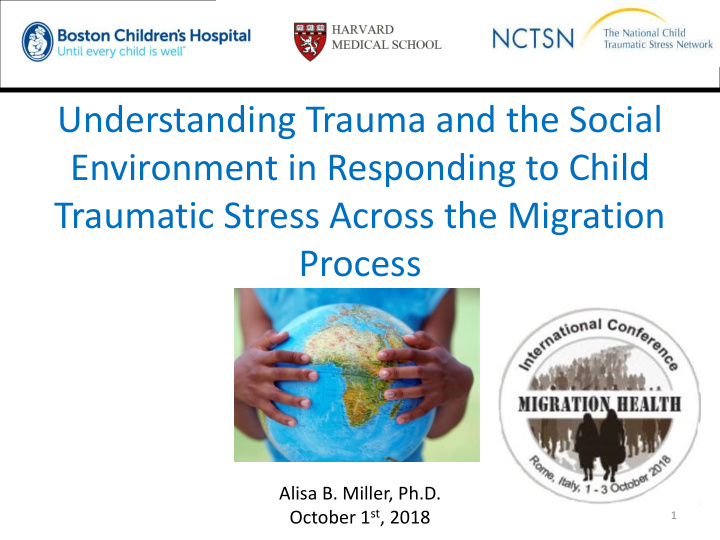



Understanding Trauma and the Social Environment in Responding to Child Traumatic Stress Across the Migration Process Alisa B. Miller, Ph.D. October 1 st , 2018 1
Learning Objectives 1. Review the spectrum of potentially traumatizing situations for children: before, during and after migration 2. Describe a theoretical model of child traumatic stress 3. Outline the key elements of clinical program for the treatment of child traumatic stress in pediatric migrants, Trauma Systems Therapy for Refugees (TST-R)
OVER HALF OF THE REFUGEES WORLDWIDE ARE UNDER THE AGE OF 18 (UNHCR, 2017) Image taken from: https://png.pngtree.com/element_origin_min_pic/16/09/04/1757cbedb66a8c6.jpg
Socio-Ecological Model Culture, Nation Community, Neighborhood Family, Peers, School Child Urie, B. (1979). The ecology of human development: Experiments by nature and design. Cambridge, MA: Harvard .
Pre-migration / migration Identity and beliefs targeted Disruption of basic scaffolding of childhood Separation from family, loss Trauma
Post Migration Discrimination Acculturative stress, peer acceptance, school readiness Intergenerational trauma, loss, acculturation Trauma
Refugee Youth Core Stressors
Understanding Traumatic Stress
What is Trauma? Trauma occurs when an individual experiences or witnesses an intense event that threatens or causes harm to his/her emotional and/or physical well-being. An event is considered traumatic when it … • Is sudden, unexpected or non-normative • Exceeds the individual’s perceived ability to meets its demands (McCann & Perlman, 1990) • Both subjective and developmentally/culturally-bound
Refugee Trauma Pre- Post Migration Migration Long, Direct Lack of dangerous Community Living in Loss of/ Torture and Traumatic Sexual Separation Poverty exposure to access to Displacement journeys on Violence separation loss of family assault and refugee detention from family/ foot or witnessing basic from family camps gender-based members/ country of violence resources loved ones violence During Migration
Traumatic stress is mediated by… Survival circuits fight flight freeze
Survival circuits – what happens in an individual with traumatic stress? Saxe, Ellis , & Brown (2016). Trauma Systems Therapy: 2 nd edition. New York: Guilford Press; Saxe, Ellis, & Kaplow, (2007). Collaborative treatment of traumatized children and teens: The trauma systems therapy approach . Guilford Press.
What Regulates Survival Circuits? Kirsch, P., Esslinger, C., Chen, O., Mier, D., Lis, S., Siddhanti, S., et al. (2005). Oxytocin modulates neural circuitry for social cognition and fear in humans. Journal of Neuroscience, 25, 11489-11493.
A stimulating, nurturing environment has a positive impact on brain development
Survival Circuits are regulated by… safe and healthy relationships
Signals of Danger Terrorism Discrimination Loss and separation of loved ones Child
Signals of Care Caring interpersonal signals can remedy the emotional dysregulation created by provocative interpersonal signals. Subtle interpersonal signals that people send each other, all the time, wittingly or unwittingly These signals can be signals of: care or carelessness; safety or danger; love or hate We all have a balance of positive and negative signals in our lives. We base our expectations of the world largely on this balance Saxe, Ellis , & Brown (2016). Trauma Systems Therapy: 2 nd edition. New York: Guilford Press; Saxe, Ellis, & Kaplow, (2007). Collaborative treatment of traumatized children and teens: The trauma systems therapy approach . Guilford Press.
Signals of Care Across the Social Environment LOVE CARE SAFETY Child
Trauma Systems Therapy for Refugees (TST-R) Continuum of Care Intensive Intervention Skill building Psychoeducation / Outreach
TST-R: Project SHIFA video Video Picture illustration taken from “The Color of Home” by Mary Hoffman (Author) and Karin Littlewood (Illustrator). http://karinlittlewood.com/index.htm
“These kids are part of our communities. And if kids in our communities do well, we all do well.” -Dr. Heidi Ellis, Director of the Refugee Trauma and Resilience Center
Recommend
More recommend